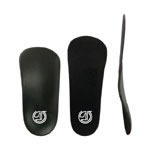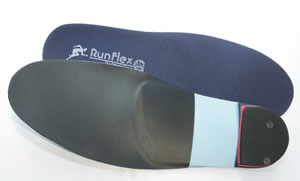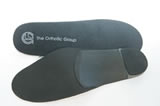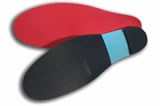Ordering Custom Made
|
 GaitScan Equipment |
  Graph analysis report |
 Showing path of foot progression |
 3D image of foot pressure |
5. Information sent to lab
The information from the medical history, the biomechanical assessment, and the computerised gait analysis is then sent to the lab for further analysis by technicians using computer aided programs to assess exactly the orthotic necessary.
6. Lab ProductionIt is important to use a high quality lab to produce the orthotics to ensure an accurate, long lasting and comfortable orthotic.
The orthotics will be ready for fitting after about 2-3 weeks.
 Everyday typical orthotic showing topcovers of different lengths Everyday typical orthotic showing topcovers of different lengths |
7. Dispensing and Break-in
Orthotics need to be carefully worn at first as they fundamentally change the way you walk. They should be worn for about 1-2 hours the first day and 2-3 hours on the second day and so on. By the end of 1-2 weeks you should be wearing them all day. Some people adjust more quickly than others. Mild discomfort, particularly in the hip area, can occur at first if the break-in period is too short. Once your body has adjusted to a new walking position these aches, if present, should quickly disappear.
8. Guarantees, Precautions, ProblemsGUARANTEE
Orthotic shell: 3 years against breakage/cracking of plastic shell with normal use
Top Cover: six months warranty on tearing and abnormal breakdown
Additions and Modifications: six months warranty on abnormal breakdown
PRECAUTIONS
Do not climb rung ladders or dig with a spade as this can put pressure along the length of the orthotic shell
Keep orthotics away from animals. Dogs tend to find orthotics quite attractive to chew.
PROBLEMS
Squeaking: dust with talcum powder before placing the orthotics in shoes
Heel slippage with some shoes: try other shoes and try to purchase shoes with a deeper heel seat. Slippage can reduce or disappear as foot function improves.
| Contact Sue Ferguson Podiatrist Book an appointment now to help your foot pain (please note I am not accepting new patients) Tel: 01580 765546 |
||
| Custom Orthotics | ||
| Orthotics for Running | ||
|
||
| Everyday Orthotics | ||
|
||
| Orthotics for Skiing | ||
|
| Sue Ferguson BSc (Hons), MRCPod Chiropodist and Podiatrist 2 St Benets Court Tenterden Kent TN30 6QS Tel: 01580 765546 Email: sjf.ferguson@gmail.com |


